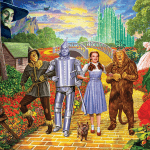The following article is adapted from psyche.co, a most fabulous online resource for understanding the human condition.
https://psyche.co/guides/how-to-understand-and-adapt-your-attachment-style
How to be more secure in your relationships
Too clingy – or too scared to commit? Your attachment style is rooted in your childhood, but you can change it.
The way you relate to other people emotionally – your attachment style – matters greatly in life. Studies that have followed the same individuals for decades have found that the ability to initiate and sustain good relationships is crucial for long-term happiness. This Guide will show you how to understand – and change – your attachment style, thus providing you with the foundation for dramatically improving your relationships.
Your attachment style has its roots in your childhood

Attachment science is based on the work of the British child psychologist John Bowlby and his colleagues in the 1950s. Bowlby believed that human beings – like other mammals – have a deep-seated need for love and nurturance from their parents or other carers, and that if this care is absent or unreliable, it can lead to long-term problems, including relating to other people. Subsequent laboratory studies, including the Strange Situation experiments led by another psychologist, Mary Ainsworth, put empirical meat on the bones of Bowlby’s ideas. She showed that children responded in different ways to being separated from their caregivers, which she interpreted as being dependent on the nurturance style of their caregivers.
Later on, researchers such as Cindy Hazan and Phillip Shaver, and L Alan Sroufe (who leads the Minnesota Longitudinal Study of Risk and Adaptation), took things further, showing how early life experiences with our key caregivers shape our expectations – consciously and unconsciously – of what to expect from relationships throughout our lives. This includes friends, family members, peers, colleagues and romantic partners. Ultimately, your attachment style shapes how much you trust others, whether you fear abandonment, and whether you keep your distance from others – or push them away – to avoid intimacy.
Of course, the science of attachment does not explain everything about our relationships, and it’s not without its critics. For example, we don’t have a complete understanding of the factors that influence attachment styles, and it would be naive to ignore the genetic influence on temperament. On balance though, as practising psychotherapists, we believe that attachment theory remains a useful shorthand to help us navigate our relationships and change our behaviour in ways that will make our lives more fulfilling.
Your attachment style plays out in your adult relationships
Consider these examples of how attachment style can play out in relationship dynamics and see if you can recognise yourself or anyone you know in any of them:
Ravi is at home, having cooked dinner as usual, waiting for his partner Frankie to return from work. She’s 10 minutes late, and his head starts to spin. He begins to worry. ‘She didn’t tell me she would be late,’ he thinks. ‘She’d have texted me if she was delayed.’ Within minutes, Ravi’s worry has turned to anger and resentment. ‘How dare she? She knew I was going to be cooking dinner. She always does this, never thinking about me. I bet she’s not even aware I’m worried about her. She doesn’t care how she makes me feel.’ When Frankie eventually does arrive home, a defensive argument takes place instead of dinner and the planned catch-up about their days.
Diane is about to have The Chat with her partner. She’s decided to end yet another relationship. This one started brightly, like they often do for Diane – full of passion and fun. But it quickly went downhill as soon as her partner started developing intense feelings. There’s something about being loved so intensely that makes Diane close up and need to run away. So, ending it with her partner feels like Diane’s only option. She’s starting to think she’ll never have a solid romantic relationship. ‘Is it me?’ Diane thinks. ‘Or do I just attract – and am I just attracted to – intense people?’
Dave’s boss reminds him of his parents. She’s pleasant on the surface, she helps him when he asks for support, but whenever she offers him feedback on his performance, Dave can’t help but feel criticised, undermined and, frankly, embarrassed. ‘Why does this stuff still bother me?’ Dave wonders. ‘I’m a grown man, I know I’m good at what I do, I want to get ahead here, but I’m yet again in a situation where I hate my boss and I’m starting to lack self-belief.’ This has happened before, and Dave is starting to wonder if he’ll ever realise his potential.
At least one of those three examples will likely resonate, either because you identify something of yourself, or you can spot similarities with someone you know or love. The examples show how different kinds of attachment style can play out in relationships of all kinds – with our loved ones, our friends, our children, and with our colleagues and bosses.
Crucially, attachment science suggests that, unless you understand and seek to change your attachment style, you will likely continue to manage your current relationships based on the habits you learned in childhood from your earliest caregivers. For example, perhaps you are clingy in relationships, desperate for your partner’s attention in order to feel secure – it’s likely these responses are deeply embedded in what you saw, and how you were treated, in relationships in your childhood. Fortunately, by trying out new behaviours in relationships, and finding new coping behaviours when you’re feeling anxious or stressed, you can change your attachment style, enjoy better relationships, and lead a more fulfilling life. In the steps that follow, we’ll show you how to explore your own attachment style and begin changing it, if you want to.
Identify your current attachment style
The first step in understanding why you behave the way you do in relationships is to identify your current attachment style. You could complete a free online test, such as this one that’s been used in attachment research. Even easier, select which of these four statements you feel best describes you:
- It is easy for me to become emotionally close to others.
- I want to be completely emotionally intimate with others, but I often find that others are reluctant to get as close as I would like, and I am uncomfortable being without close relationships.
- I am comfortable without close emotional relationships. It is very important for me to be independent, and I prefer not to depend on others.
- I am deeply uncomfortable getting close to others. I want emotionally close relationships, but I find it terrifying and chaotic to trust others.
Each of these four statements corresponds to one of the four main attachment styles recognised by psychologists. If you chose (1) this suggests you have a secure style; (2) an anxious style; (3) an avoidant style; and (4) a disorganised style.
We’ll explain what these terms mean in a moment, but before we do, it’s important to try as best as you can to not judge yourself harshly based on your attachment style (admittedly the labels for the different styles, which are rooted in attachment research, aren’t super helpful in this regard). It won’t help you make the changes you want in your life if you see your attachment style as fundamentally negative. Remember, every attachment style is a learned response to a specific set of circumstances. If you have an insecure style, you did what you could, and your style will have positives as well as negatives, even if you ultimately want to change it.
Remember too that your attachment style is not your destiny. A range of studies have found only a moderate correlation between infant attachment behaviour and later adult attachment behaviour in the same individuals. This shouldn’t be that surprising: a range of factors play into our relationship expectations and behaviours, including genetic temperament. These factors don’t stop at the end of childhood, either. Supportive coaches, teachers and friends can impact and change our attachment expectations and beliefs. We can learn to trust others more deeply, and lean into healthy relationships with safe adults and peers. So, while our earliest relationships shape our relationships in our adult lives, they are not the only influence. That can offer hope: if we make the right choices about who we surround ourselves with (or if we’re lucky enough to stumble upon them), we can offset some of the negative impacts of the first few years of our lives.
Understand the four attachment styles

Once you understand the science of attachment, you’ll have a platform from which to understand yourself in relationships, and to better understand those you care about, perhaps including: why you keep making the same mistakes, why people keep leaving you/why you keep leaving them, why you keep losing jobs/missing out on promotion – and what you can do to change. The trick is to understand that often you expect to get treated based on how you got treated.
If you’re fortunate enough to have a secure attachment style, your primary caregivers were probably ‘good enough’ (the psychoanalyst Donald Winnicott’s term for mothers who are emotionally sensitive and responsive) and you are well placed to enjoy healthy relationships in life. However, the other three main attachment styles are insecure, and can lead to difficulties in building and maintaining good relationships:
An anxious attachment style (sometimes called ‘preoccupied’ or ‘ambivalent’) is often due to inconsistent or intrusive parenting, or a blurring of the boundaries between parent/caregiver and child, for example by exposing the child to inappropriately adult emotions and situations too early in life. If this is your attachment style, then as an adult you probably value closeness and connection, but find yourself worrying about upsetting others or being rejected, and you might tend to assume the worst is happening in a relationship. You might find yourself prone to jealousy and clingy behaviour as a result, or you might be tempted to withdraw and resort to passive aggression, such as giving others the ‘silent treatment’.
An avoidant attachment style (sometimes called ‘dismissive-avoidant’ or ‘fearful-avoidant’ depending on the accompanying behaviours) is linked to a caregiver’s consistent and repetitive rejection of the child’s emotional needs. If this was your experience, then as an adult you might find you always try to cope on your own. You probably reject the need for relationships or, if you are in them, you may find it difficult to become emotionally close, or place a lot of value on your partner’s looks. You might prefer not to pay too much attention to other people’s emotions and you’re probably inclined to see yourself as not having any problems.
The final attachment style – the disorganised style (sometimes called ‘disoriented’) – is best thought of as like being trapped in, and responding to, a terrifying and incredibly confusing stay/go paradox, where the caregiver (and future potential friends or partners) are both the source of occasional comfort but, more often, the source of threat. This style is linked to serious abuse and neglect in childhood. If this was something you experienced, you might struggle with self-esteem and have perhaps found your subsequent relationships incredibly difficult because of the intense emotions you experience.
Examine the attachment styles of those you love

Attachment is fundamentally a science of relationships. Yes, we want to know more about ourselves, but we also want to influence those we care about to feel emotionally safe in their relationship with us. So, once you feel like you understand your own attachment behaviours, start looking to those around you to more fully understand why they behave the way they do in their close relationships.
If someone is clingy and intense, perhaps they have an anxious attachment style. In contrast, someone who often seems removed or aloof might have an avoidant style. These differences play out in many everyday situations. Someone with a more anxious style will tend to be annoyed or fretful that their partner is five minutes late home (driven by an underlying fear of abandonment, perhaps) – think of Ravi, whom we met earlier. In contrast, those with an avoidant style are more likely to think: ‘Who cares that I’m home five minutes late? And why is he still going on about it?’ This is a familiar pattern in relationships – the anxious/avoidant pairing, where one partner moves towards the other for signs that they care, but ironically their desperation annoys and pushes away the other, rather than each being able to say what they want or need. Diane, in our earlier examples, has a more avoidant style – moving away from others when she feels smothered by her partner’s closeness. Meanwhile, Dave had elements of a disorganised style, with his significant lack of self-esteem and hatred of his boss.
If you and your relationship partner don’t understand each other’s attachment styles, you’re more likely to keep repeating the same behaviours and arguments. Moving towards your partner – truly seeking to understand why they’re upset, without jumping into an apology too quickly – requires an attempt at understanding, and an attempt at seeing the world through their eyes. You can do that from afar, in your own mind, or you can do it more effectively by showing interest and curiosity about why they behave the way that they do. What does it feel like for them when you get angry with them? What’s it like for them when you fail to show sufficient interest in how they’re feeling? Why do they care so much that you don’t have as much sex as you used to? Yes, attachment behaviour and expectations show up in the bedroom, too.
This will give you the information you need to change your behaviour to meet more of your partner’s needs. For example, if your partner is more on the anxious end of the scale and you’re on the avoidant end, it can help to reflect that, rather than just being needy or clingy, your partner is signalling to you through their attachment behaviour that they want a bit more from you. Maybe they are feeling that deep-seated fear of abandonment, first felt in childhood. While you might not need to be soothed when your partner hasn’t called or texted for a while, they might start to feel insecure at the absence of communication. Try to bring empathy and understanding to others’ attachment behaviours, and you’ll be more likely to meet their needs, and understand more about how they are able to meet yours.
Partners with a disorganised attachment style lack a coherent approach toward relationships. On the one hand, they want to love and be loved. But they are afraid to get close to anyone, because they have a strong fear-based on experience – that those closest to them are the most dangerous and will hurt them. Knowing that these partners want relationships, but fear them, can help you tolerate their lack of consistency and behaviours that, on the surface, look like they’re pushing you away. They’re likely getting the rejection in first because they believe pain and hurt inevitably arise from closeness. You’ll need to stick with them, tough it out, and reassure them explicitly and implicitly that you’re safe. This is about proving, time and again until they truly feel it, that they can trust you, and that you’re not going to reject them – while paying attention to your own needs and boundaries, of course.
Work towards changing your attachment style
Neuroscience research is increasingly showing that the human brain remains malleable and capable of adjusting throughout life, into old age. This is certainly true for the brain networks underlying the ability to regulate our emotions, which is directly relevant to attachment styles.
So, if you’re struggling to make the changes you want to make in your relationships and you keep making the same mistakes, take a beat and bring yourself back to these key points:
- you can learn to handle emotions differently;
- you can change your attachment style; and
- you can change your expectations about relationships.
As we said earlier, attachment style is not destiny – it can change, and you can choose to change it.
Here are some additional ideas that might help you:
- Practise spotting your patterns of behaviour in relationships – and their consequences.
You might not need a lot of reassurance in a relationship – perhaps because you currently have a more avoidant style. You know your partner loves you, and they should know you love them, so why keep saying it? But perhaps they do need a bit more reassurance than you, and you’ve seen how this mismatch creates friction. So, rather than dismissing them as needy, have a think about why – from an attachment perspective – they might need a little more from you, and adjust your behaviour accordingly. Over time, this could help you become less avoidant and improve your relationship.
- Collaborate with your partner to change your attachment style.
If you’re anxious, ask for patience and tolerance from your partner, while at the same time committing to acting less from that anxious place. If your partner understands that you’re anxious, it might help them to know that it won’t help you to constantly reassure you that they love you; on the contrary, the route to attachment security is trust built over time. Alternatively, if you’re more avoidant, your partner can help by giving you space when you need it, but also by gently coaxing you into intimacy (romantic dinners, meaningful conversations, invitations to have sex). Others can help you challenge yourself to act in new ways, and have new experiences, if you let them.
- Keep practising new ways of engaging with others.
If you have an anxious attachment style, practise being direct and authentic with others, even though it feels hard. If you struggle to calm yourself without another person to help, there are many techniques you can use that will help you to manage any intense emotions that arise. If you’re more avoidant and struggle to connect with others, challenge yourself to stay present in disagreements and seek to understand the person opposite, rather than running away. None of this is easy but, over time, you’ll begin to notice the differences in how you behave and you’ll start to feel more secure.
- Create a virtuous circle (ideally in collaboration with your partner/friends).
It goes something like this: (a) notice when you’re on autopilot – for instance, lapsing into needy or avoidant behaviours; (b) pause to reflect; (c) do something different; (d) notice the results; and, if they were positive, (e) apply what you’ve learned in future situations.
You can also apply these principles for changing your attachment style beyond romantic relationships: to friendships, family relationships and work relationships. For example, imagine that your boss thinks you need to improve a piece of work, but you get annoyed that they have deigned to criticise you (similar to our earlier example involving Dave, whose critical boss reminded him of his parents). Knowing that you have an insecurity about people criticising you, and knowing that this insecurity is based on your early experiences of being criticised by your parents, gives you the power to avoid replaying past behaviours. You can now take a breath, and try to prevent an angry, defensive response that you might have reached for in the past (thus setting in train the virtuous circle we mentioned above).

Finally, a reminder that this is life-long work. Be on the lookout for ‘corrective experiences’ and opportunities to learn every day, and try to lean into them. You’re not going to get this right every time. You’ll get angry, clingy, grumpy, childlike again and again. We all do. So give yourself a break; you won’t see overnight changes. We’re all human, so we have a tendency to fall back on familiar habits and ways of behaving. But we can also learn and adapt too. Like a tennis player practising their backhand, to be the best you can be and make the greatest gains, you’ll need to concentrate on what you find most difficult. Good luck!
How to be more secure in your relationships
- Your attachment style has its roots in your childhood. Attachment science originated in the 1950s with the child psychologist John Bowlby, who argued for our deep-seated need for love early in life.
- Your attachment style plays out in your adult relationships. Early life experiences with your caregivers shape your expectations – consciously and unconsciously – of what to expect from relationships throughout your life.
- Identify your current attachment style. This will help you understand why you behave the way you do in relationships. There are free tests you can take online, including a mini quiz in this Guide.
- Understand the four attachment styles. There is a secure attachment style, and there are three insecure styles: anxious, avoidant and disorganised. Key to them all is that you often expect to get treated based on how you got treated.
- Examine the attachment styles of those you love. If you and your relationship partner don’t understand each other’s attachment styles, you’re more likely to keep repeating the same behaviours and arguments.
- Work towards changing your attachment style. If you want, there are ways you can begin to deliberately change your attachment style, not only in the context of romantic relationships but also with your friends, family and colleagues. Part of this is about noticing patterns in your behaviour and practising responding differently.
Working on your attachment style in therapy

If you’re keen to better understand and address your attachment style but you feel you need more support, you could consider seeking out a professional therapist. Directories such as Psychology Today in the United States or Welldoing in the United Kingdom allow you to search by therapist orientation; choosing a therapist who is attachment orientated might help (there’s more advice on choosing a psychotherapist in this previous Psyche Guide).
We’re both therapists ourselves, and we draw on attachment theory every day in our clinical work. One of us trained at the UK’s leading institution for attachment-based therapy, the Bowlby Centre; the other is currently its chair. We find the concept of attachment incredibly helpful when supporting clients to rethink how they want to behave in the most important relationships in their lives. To be clear, we’re not talking here about the controversial and discredited ‘attachment therapy,’ which can involve firmly holding down children against their will to gain their obedience. Instead, drawing on attachment-informed therapy, a therapist can help you shift from an insecure to a more secure style of attachment by drawing on the following core principles, based on more than 50 years of empirical evidence:
- Promoting your hope and expectation that therapy can help: most of the time, for most people, with most problems, therapy is effective at relieving distress.
- Establishing a good working relationship with you: thus helping to build your attachment security in a safe relationship.
- Helping you become more aware of what causes your attachment difficulties: by standing back to see the wood for the trees, or zooming in to see the detail, as it really is.
- Encouraging you to engage in ‘corrective experiences’: encouraging and supporting you to do things differently, to learn something new or unexpected – especially in those areas of life you find most uncomfortable to confront.
- Practising ongoing reality testing: supporting you in creating that virtuous circle we mentioned earlier!
To take a simple example of a corrective experience in therapy: say you arrive five minutes late to your session. You’re anxious, you’re stressed, you’re feeling deeply sorry for wasting your therapist’s time. This would suggest an anxious attachment style based on the fear of rejection, conflict avoidance and people-pleasing. Your therapist might compassionately show interest in why you’re feeling so apologetic and why you assume they will feel put out or annoyed at you. They know this is replaying something about your past, so the therapist would help you to look at it, and question it. They might explore with you how they really felt (maybe worried about you, concerned that you might be stressed). Taken all together, they’ll offer you a new experience of having someone who cares about you and shows an interest in you.

Couples counselling can be a particularly effective way for both partners to explore their attachment expectations and to develop new ways of responding to attachment insecurities together. Good couples therapy helps you understand flashpoints and work out what’s really going on underneath the arguments about coffee cups, dishwashers and childcare – and how to have better conversations about what’s really going on.
Finally, it’s worth pointing out that – particularly at the extreme ends of the insecure attachment styles, and disorganised attachment especially – talking therapy might not be sufficient. If you feel that your attachment style is causing you ongoing problems that you haven’t been able to address on your own or with the support of others, you might consider speaking to your general practitioner (or primary care physician) about prescription drugs that could help alleviate an underlying difficulty with anxiety or low mood (this Psyche Guide on how to decide whether to take antidepressants is an excellent resource). Overall, please take heart that there are various forms of help and support out there, and you can learn new, more positive ways of relating to others.
The book Attached (2010), by the psychiatrist and neuroscientist Amir Levine and the psychologist Rachel Heller, offers a neatly packaged introduction to attachment within romantic relationships.
An oldie but goodie is the article ‘Becoming Attached’ (1990) by Robert Karen in The Atlantic.
The film Good Will Hunting (1997) explores avoidant attachment in male relationships and is one of the best examples (within reason!) of a good therapy relationship on screen. The animated film Frozen (2013) is a great way to introduce attachment to your kids, and offers a neat example of how we can change our attachment styles – see if you can work out who is anxious and who is avoidant, and who needs to ‘Let It Go’…
The track ‘I Am a Rock’, first recorded by Paul Simon, which he later performed and released with Art Garfunkel in 1966, vividly captures avoidant attachment.
Finally, have a look at our site – the London Centre for Applied Psychology – for articles, training courses and other resources. We have lots on attachment there, as well as on the other ways in which an understanding of contemporary psychology can help improve your life.
Disclaimer
We work hard to bring you the most trustworthy, expert and up-to-date information on psychology and mental health in our Guides. You can learn more about how we ensure that they are a reliable source of information here. This Guide is provided as general information only. It is not a substitute for independent, professional medical or health advice tailored to your specific circumstances. If you are struggling with psychological difficulties, we encourage you to seek help from a professional source.
https://openpsychometrics.org/tests/ECR.php